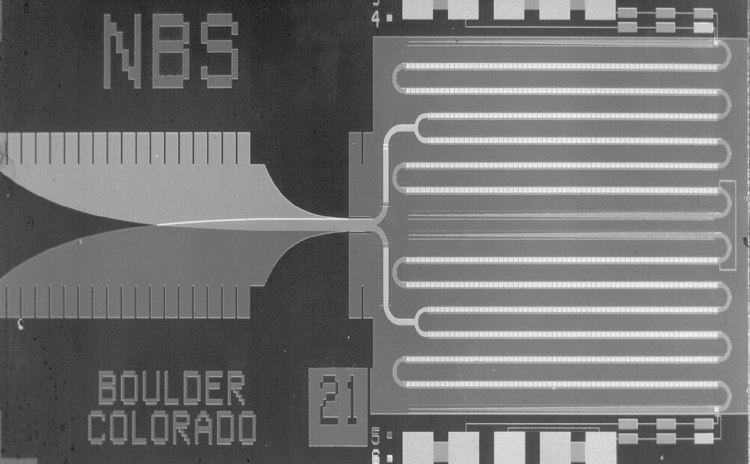 | ||
The Josephson effect is the phenomenon of supercurrent—i.e. a current that flows indefinitely long without any voltage applied—across a device known as a Josephson junction (JJ), which consists of two superconductors coupled by a weak link. The weak link can consist of a thin insulating barrier (known as a superconductor–insulator–superconductor junction, or S-I-S), a short section of non-superconducting metal (S-N-S), or a physical constriction that weakens the superconductivity at the point of contact (S-s-S).
Contents
- Applications
- The effect
- The DC Josephson effect
- The AC Josephson effect
- The inverse AC Josephson effect
- Josephson phase
- Josephson energy
- Josephson inductance
- Josephson penetration depth
- References
The Josephson effect is an example of a macroscopic quantum phenomenon. It is named after the British physicist Brian David Josephson, who predicted in 1962 the mathematical relationships for the current and voltage across the weak link. The DC Josephson effect had been seen in experiments prior to 1962, but had been attributed to "super-shorts" or breaches in the insulating barrier leading to the direct conduction of electrons between the superconductors. The first paper to claim the discovery of Josephson's effect, and to make the requisite experimental checks, was that of Philip Anderson and John Rowell. These authors were awarded patents on the effects that were never enforced, but never challenged.
Before Josephson's prediction, it was only known that normal (i.e. non-superconducting) electrons can flow through an insulating barrier, by means of quantum tunneling. Josephson was the first to predict the tunneling of superconducting Cooper pairs. For this work, Josephson received the Nobel Prize in Physics in 1973. Josephson junctions have important applications in quantum-mechanical circuits, such as SQUIDs, superconducting qubits, and RSFQ digital electronics. The NIST standard for one volt is achieved by an array of 19,000 Josephson junctions in series.
Applications
Types of Josephson junction include the pi Josephson junction, varphi Josephson junction, long Josephson junction, and Superconducting tunnel junction. A "Dayem bridge" is a thin-film variant of the Josephson junction in which the weak link consists of a superconducting wire with dimensions on the scale of a few micrometres or less. The Josephson junction count of a device is used as a benchmark for its complexity.The Josephson effect has found wide usage, for example in the following areas:
The effect
The basic equations governing the dynamics of the Josephson effect are
where
The three main effects predicted by Josephson follow from these relations:
The DC Josephson effect
The DC Josephson effect is a direct current crossing the insulator in the absence of any external electromagnetic field, owing to tunneling. This DC Josephson current is proportional to the sine of the phase difference across the insulator, and may take values between
The AC Josephson effect
With a fixed voltage
This means a Josephson junction can act as a perfect voltage-to-frequency converter.
The inverse AC Josephson effect
If the phase takes the form
The DC components will then be
Hence, for distinct AC voltages, the junction may carry a DC current and the junction acts like a perfect frequency-to-voltage converter.
Josephson phase
The Josephson phase is the difference of the phases of the quantum mechanical wave function in two superconducting electrodes forming a Josephson junction.
If the macroscopic wave functions
then the Josephson phase is defined by
Josephson energy
The Josephson energy is the potential energy accumulated in a Josephson junction when a supercurrent flows through it. One can think of a Josephson junction as a non-linear inductance which accumulates (magnetic field) energy when a current passes through it. In contrast to real inductance, no magnetic field is created by a supercurrent in a Josephson junction — the accumulated energy is the Josephson energy.
For the simplest case the current-phase relation (CPR) is given by the first Josephson relation:
where
Here
Josephson inductance
Imagine that the Josephson phase across the junction is
(This is the same equation as above, except now we will look at small variations in
Imagine that we add little extra current (direct or alternative)
Assuming that
The voltage across the junction (we use the 2nd Josephson relation) is
If we compare this expression with the expression for voltage across the conventional inductance
we can define the so-called Josephson inductance
One can see that this inductance is not constant, but depends on the phase
One can also calculate the change in Josephson energy
Making Taylor expansion for small
If we now compare this with the expression for increase of the inductance energy
Note, that although Josephson junction behaves like an inductance, there is no associated magnetic field. The corresponding energy is hidden inside the junction. The Josephson Inductance is also known as a Kinetic Inductance - the behaviour is derived from the kinetic energy of the charge carriers, not energy in a magnetic field.
Josephson penetration depth
The Josephson penetration depth characterizes the typical length on which an externally applied magnetic field penetrates into the long Josephson junction. Josephson penetration depth is usually denoted as
where
where
